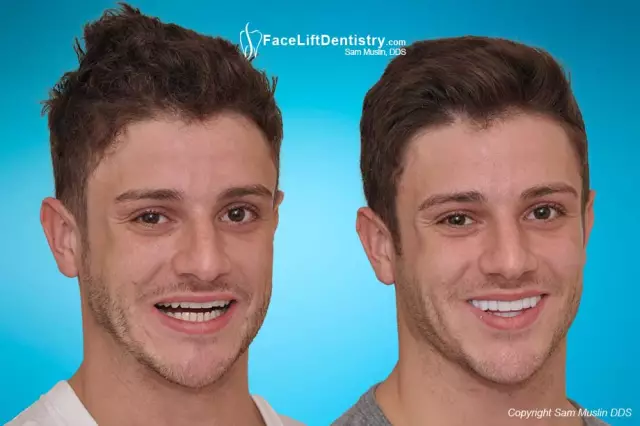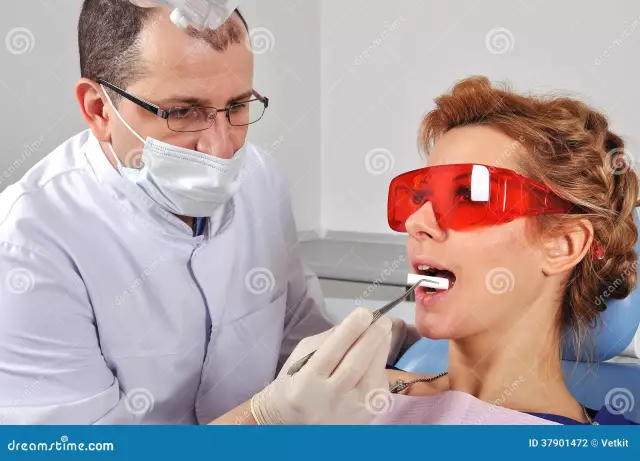- Author Curtis Blomfield [email protected].
- Public 2023-12-16 20:44.
- Last modified 2025-06-01 06:18.
What are physiological bites? Why are they good? You will find answers to these and other questions in the article. A bite is called the position of the teeth when the lower and upper dentition come into contact during the complete connection of both jaws.
Dentists use the term "occlusion" to describe the bite of the teeth. What it is? Occlusion is the closure of both jaws at the stage of movement towards each other. Physiological and pathological bites will be discussed below.
Central occlusion
Few people know what physiological bites are. The final position, which ends the chewing movement of the jaws, is called central occlusion. Under these conditions, the middle of the human face coincides with the line that runs between the nodal incisors. In this case, the head of the lower jaw is placed on the slope of the articular eminence, at its base. The muscles that lift the lower jaw are equally and extremely tense on both sides.

Thus, the bite of the teeth is the relationship of both dentitions during central occlusion.
Types of bite
There are various variations in the relationship of the teeth of both jaws during central occlusion. According to them, different types of bite of teeth are established, which are divided into two groups:
- Physiological (correct) bite.
- Malocclusion (malocclusion).
Correct bite

Physiological bite is established when, when both jaws are connected, the teeth of the upper group block the lower ones by about a third, and the molars interact with each other so that the antagonist teeth clearly close with each other. Basic signs of a classic bite of teeth:
- The median conditional line of the face passes between the central lower and upper incisors.
- When the jaws are closed, the teeth of the upper row interact with the rear teeth of the same name of the lower tier. And vice versa.
- Speech and chewing activity is not disturbed.
- There are no gaps between side by side teeth of the same row.
Types of correct bite
Correct bite is of the following types:
- Orthognathic bite - the upper tier of teeth during the closing of the jaws blocks the lower one. At the same time, in the anterior segment, the upper incisors cover the lower ones by about a third. Dentists today consider this type of bite to be the reference.
- Progenic bite - the lower jaw at the moment of joining the teeth is slightly pushed forward.
- Bite straight - incisors of the upper row of teeth during closure of the jawsthe lower ones do not overlap, but are connected by cutting edges to each other.
- Biprognathic bite - the lower and upper incisors are tilted towards the vestibule of the oral cavity during the connection.
Any modification of the correct bite allows the dentition to work fully, providing a standard aesthetic appearance of the face, typical diction and 100% performance of chewing functions.
Abnormal bite
Incorrect bite is produced as a result of acquired (due to any ailments, etc.) or congenital (genetic) defects of the jaws or dentition.

The key sign of an abnormal bite is a variety of deviations from the sample when the lower and upper teeth are closed, up to a complete lack of adhesion in some areas, which leads to a breakdown in the activity of the dentoalveolar system, as well as a distortion of the correct outlines of the face. Depending on the nature of the discrepancy, the following types of abnormal bite are distinguished:
- Open bite - most of the teeth of both jaws do not meet.
- Deep bite - the upper incisors overlap more than 50% of the facial surface of the lower incisors.
- Mesial bite - the lower jaw protrudes noticeably forward in relation to the upper jaw.
- Distal bite - the lower jaw is infantile, and the upper jaw is too developed.
- Cross bite - infantility of one side of some jaw.
- Dystopia - part of the teeth is placed incorrectly, out of place.
Each of the speciesmalocclusion can lead to undesirable consequences for your body. In addition to aesthetic problems with distorted facial contours and uneven teeth, malocclusion can accelerate the progression of a number of ailments in both the body and the oral cavity.
Today, a huge number of people have some form of malocclusion. Fortunately, all types of this anomaly can be healed with modern orthodontic treatment. You just need to visit the orthodontist in time and choose the treatment method and the most suitable course for you. The sooner you do this, the more effectively and quickly such healing will be performed.
When is the best time to treat?
Pathological types of occlusion are best treated in childhood, when the growth of jaw bones and teeth has not yet been completed. However, the current orthodontics is able to straighten the bite in an adult very effectively.

To prevent an ailment, of course, is much easier than to eliminate, given the long-term orthodontic treatment. Therefore, take care of your baby's teeth immediately as they erupt, and then bite defects can certainly be avoided.
Open view
Let's look at malocclusion in a little more detail. The signs of an open bite are known to be:
- tight closing of lips;
- slightly elongated oval face;
- deviations in pronunciation;
- problematic swallowing and chewing.

This type of malocclusion can be divided into several modifications. First, based on the occurrence factor:
- Traumatic - caused by the loss of one or more milk teeth, as well as thumb sucking or nipple addiction.
- True - appears due to disorders in the structure of the bone tissue of the lower and upper jaws. Healing lends itself, but it is too difficult.
Secondly, based on the peculiarity of the flow:
- Lateral - The lateral teeth do not touch at all.
- Frontal - the connection of the jaws occurs at the location of the front incisors.
Deep bite symptoms
Deep bite is the most commonly diagnosed. Its basic features include:
- Very fast and severe tooth wear. This is due to the fact that with an incorrect deep bite, the individual often grinds his teeth.
- Strong overlap of the lower dental tier with the upper one. The average person, who is not a specialist, in this case can easily notice some reduction in the lower part of the face and unpleasant placement of teeth.
- Frequent headaches. This symptom is not observed in all patients.
- Pain in the area of the lower jaw joint and in the temples. Their causes are a disorder of the standard activity of the masticatory muscles.
Cross view
Crossbite is an abnormal placement of the lower tooth in relation to the upper. Outwardly, this is revealed by the asymmetry of the face. Also here is the lower andthe upper zone of the jaw is very narrowed. If the described disorder is characteristic of both segments of the jaw at the same time, then they speak of the presence of such an ailment as a bilateral crossbite.

But very often such a bite affects only the side and front teeth. The indicators of this type of anomaly are:
- Problems in the activity of the gastrointestinal tract due to the fact that the teeth do not properly perform their chewing duties.
- Crunching during mouth opening and pain resulting from dysfunction of the temporomandibular joint.
- Caries increasing with increased load on the teeth.
- Pronunciation problems (mainly for toddlers).
Distal view
The distal view of the bite is outwardly manifested by the too large size of the upper jaw zone. Another situation is also encountered - incomplete formation of the lower jaw. When recognizing this ailment, a person cannot carelessly close his lips, and his face has a significant bulge. Among the known consequences of this type of bite are:
- Severe pain when opening the mouth and performing chewing movements.
- Serious risk of developing and further worsening caries.
- The occurrence of periodontitis and, as a result, the loss of most of the teeth.
- Inability to install implants.
- Disorder of such important functions of the human body as facial expressions, swallowing, pronunciation, and in advanced cases - breathing.
Mesial view
Mesial occlusion is completely opposite to distal. Here we are dealing with a significant protrusion of the lower jaw, as a result of which the human face seems to be curved. Mesial and distal types of occlusion are similar to each other, so the consequences in the absence of the necessary healing are identical.
Perfect bite

We have already said that a direct bite is a kind of correct bite, which is extremely close to the ideal. Some orthodontists believe that the setting of teeth in a direct bite is defective, as it leads to their rapid abrasion during contact. They argue that this type of bite is a borderline form between the correct bite and abnormal. The presence of this type of bite for its owner can have such undesirable consequences:
- Increased abrasion of teeth, affecting the aesthetics so that the person's lower third of the face is reduced.
- When the form is advanced, diction may be disturbed, hearing may decrease and pain in the temporomandibular joint may occur.
- As a result of the wear of the dentition, dysfunction of the temporomandibular joint appears.
With a strong abrasion of the enamel, polished surfaces of the cutting edges of the teeth are obtained, which are highly resistant to caries. At the same time, damage to the teeth by periodontal disease occurs no more often than with another form of correct bite.
Bite in babies
In the development of bite in children, there are three basic periods:
- Temporary: from appearancemilk first tooth until the permanent first tooth.
- Replaceable: a period of smooth replacement of milk teeth by permanent ones.
- Permanent: The period of the formed bite when all primary teeth have been replaced by permanent teeth.
Dentofacial defect is considered to be finally formed in the period of permanent occlusion, and in the period of changeable and temporary occlusion it can be perfectly corrected. From early childhood, observe the bite of the baby, and if you notice a deviation from the norm, start orthodontic treatment. Stay he althy!






